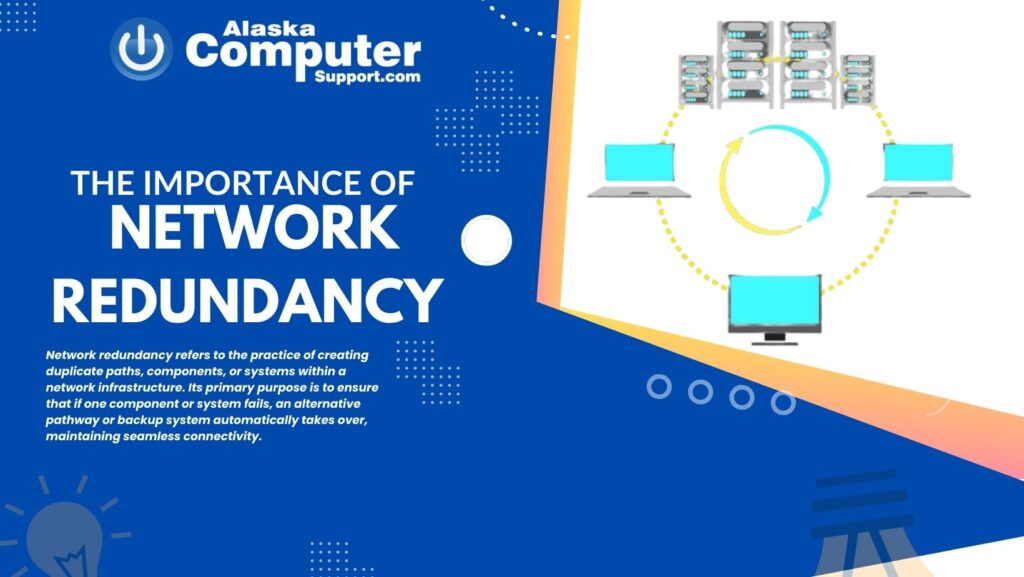The Importance of Network Redundancy

Reliable and uninterrupted network connectivity is crucial for businesses in today’s digital age. However, network failures and service disruptions can occur unexpectedly, leading to costly downtime and frustrated users. This is where network redundancy comes into play. In this article, we will explore the importance of network redundancy and how it can significantly enhance the reliability and availability of your network infrastructure.
Understanding Network Redundancy
Network redundancy refers to the practice of creating duplicate paths, components, or systems within a network infrastructure. Its primary purpose is to ensure that if one component or system fails, an alternative pathway or backup system automatically takes over, maintaining seamless connectivity. There are various types of network redundancy, including hardware redundancy, software redundancy, and geographic redundancy. Each type serves a unique purpose in safeguarding network operations against potential failures.
Benefits of Network Redundancy
Implementing network redundancy brings several key benefits to organizations:
Increased Network Reliability and Availability
By integrating redundant components and systems, network reliability is significantly enhanced. Redundancy eliminates single points of failure and provides alternate pathways, ensuring that even if one element malfunctions, the network remains operational. This results in improved uptime and availability for critical business operations.
Mitigation of Single Points of Failure
Networks are susceptible to single points of failure, which can cripple an entire infrastructure. Network redundancy mitigates this risk by distributing traffic and workload across redundant components, reducing the dependency on any single element. This redundancy eliminates vulnerabilities and ensures that failures in one area do not impact the entire network.
Minimization of Downtime and Service Disruptions
Downtime can have severe financial implications for businesses, leading to loss of productivity, revenue, and customer trust. Network redundancy helps minimize downtime by providing immediate failover mechanisms. In the event of a failure, traffic seamlessly reroutes to redundant components or systems, preventing service disruptions and keeping operations running smoothly.
Common Network Redundancy Techniques
There are several common techniques employed to achieve network redundancy:
Redundant Network Equipment and Components
Using duplicate network devices, such as switches, routers, and firewalls, ensures that if one device fails, another takes over seamlessly. Redundant power supplies and network interface cards (NICs) also contribute to the overall redundancy of the system.
Load Balancing and Failover Mechanisms
Load balancing techniques distribute network traffic across multiple redundant paths, optimizing performance and minimizing the strain on any single component. Failover mechanisms automatically detect failures and redirect traffic to alternative paths or systems, ensuring uninterrupted connectivity.
Geographically Diverse Data Centers and Cloud Services
Geographic redundancy involves replicating data centers or leveraging cloud services in different physical locations. By doing so, organizations can ensure that if a disaster or service interruption occurs at one location, operations can seamlessly transition to another, maintaining business continuity.
Implementing Network Redundancy
Assessing Network Requirements and Identifying Critical Components
Before implementing network redundancy, it is essential to assess the specific requirements of your network infrastructure. This involves understanding the critical components that are susceptible to failures and can significantly impact network performance and availability. Conduct a thorough analysis of your network architecture, identifying routers, switches, servers, or any other crucial elements that require redundancy.
Designing Redundant Network Architectures
Once you have identified the critical components, it’s time to design redundant network architectures. This involves creating duplicate pathways, systems, or devices to ensure failover capabilities. Develop a comprehensive plan that outlines the redundancy measures to be implemented, such as redundant hardware, load balancing mechanisms, or geographically diverse data centers. Pay attention to redundancy at both the local and wide area network levels to address potential failures effectively.
Testing and Monitoring Network Redundancy Implementations
After implementing network redundancy measures, thorough testing and continuous monitoring are crucial. Testing should simulate various failure scenarios to validate the failover mechanisms and ensure seamless traffic redirection. Regular monitoring helps detect any potential issues or performance degradation, allowing prompt remediation. Implement network monitoring tools and establish protocols for proactive identification and resolution of redundancy-related problems.
Case Studies
Examples of Organizations Benefiting from Network Redundancy
Several organizations have experienced significant benefits from implementing network redundancy. For example, Company X, a multinational financial institution, achieved increased network reliability by implementing redundant routers and switches across its branch offices. This prevented service disruptions and ensured uninterrupted connectivity for their customers. Similarly, Company Y, an e-commerce giant, leveraged geographically diverse data centers to maintain uninterrupted online transactions during a natural disaster that affected one of their primary data centers.
Lessons Learned from Successful Network Redundancy Implementations
Successful network redundancy implementations offer valuable lessons for other organizations. One crucial lesson is the importance of thorough planning and design. Carefully assess the specific needs of your network, consider multiple redundancy techniques, and ensure compatibility between different redundancy mechanisms. Additionally, regular testing and monitoring are vital to verify the effectiveness of redundancy measures and promptly address any issues that arise.
Potential Challenges and Considerations
Costs Associated with Implementing Network Redundancy
Implementing network redundancy can involve additional costs. Redundant hardware, software licenses, and maintenance expenses contribute to the overall investment. However, it is essential to evaluate these costs against the potential losses incurred due to network failures or downtime. A comprehensive cost-benefit analysis should be conducted to justify the investment in network redundancy.
Complexity of Managing Redundant Networks
Managing redundant networks can be complex, requiring specialized knowledge and expertise. IT teams need to be trained in configuring, maintaining, and troubleshooting redundancy mechanisms. Additionally, changes or updates to the network architecture must be carefully implemented to ensure compatibility with existing redundancy measures. Adequate documentation and standard operating procedures are crucial for efficient management of redundant networks.
Balancing Redundancy and Performance Requirements
While redundancy enhances network reliability, it can also introduce additional latency or complexity. Striking the right balance between redundancy and performance is essential. Careful consideration should be given to the design and implementation of redundancy mechanisms to minimize any negative impact on network performance. Load balancing techniques and regular performance monitoring can help optimize network efficiency while maintaining redundancy capabilities.
